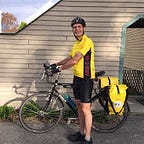Cutting Up the Economic Pie
Can everyone get a large enough piece?
This is the second Medium.com essay inspired by the book What Money Can’t Buy: The Moral Limits of Markets by Michael J. Sandel.
Ultimately there are just two economic camps. If I believe in a finite economic pie, I can only capture a greater share if my neighbor’s shrinks. If I believe in an expanding pie, I understand that my neighbor and I can both have healthy slices, that our individual portions can grow, and that, miraculously, our portions will grow even faster when they are interrelated.
Evidence of the finite economic pie exists in every specific economic transaction. If a job is available and my neighbor gets it, then I don’t. When Boston limits the number of taxi medallions (currently valued at $625,000 each), the high cost of entry makes taxis scarce and expensive. If charter schools siphon per student allocations from public schools, the public schools have less money. When China produces quality goods at lower cost, the United States loses manufacturing. The finite economic pie creates a world of winners and losers. It motivates winners to protect their advantages, hence unions, licensing, tariffs, and lobbyists; while it disenfranchises the losers from the system, hence apathy, resentment, and revolution.
However, the finite pie theory offers a restrictive view of greater economic opportunity. Our evolution from local agrarian societies to industrialized regions to a globally connected information-based world is fueled by an ever-expanding economic pie. Ideally the expanding pie can offer a job to me and my neighbor; it can stimulate demand to accommodate more taxi drivers, it welcomes schools best suited to each student’s need, and it offsets outsourced manufacturing with higher-level economic prospects at home. An expanding pie point of view recognizes the potential for future growth, but is less tangible in the here and now.
My own career is a perfect example of how an expanding economic pie works over time. I went to graduate school in architecture. At the time all architecture schools had similar curricula and students entered the job market with basic building design skills. Early in my career I worked on schools, houses, offices, even shopping centers. Then I landed a job designing a hospital and found a keen fit between my skills and the challenges of creating healthcare facilities. Within a few years I was an expert in healthcare, at least according to my firm’s marketing materials. For years I worked in every aspect of hospital design and construction but around age fifty I started to focus only on clinical planning — working with nurses and doctors to organize the building to meet their clinical needs. In the last few years, as healthcare clients became more committed to cost containment and aligning their facilities with optimal patient care, I became a Lean process facilitator. I write papers and speak at conferences about how to integrate Lean process improvement into the healthcare environments.
Thirty-five years after I joined my profession, I do work that did not exist when I began. Healthcare has become more complex, healthcare facilities have become more specialized, and the teams that create these spaces have become both larger and more expert at the multiple factors that must be considered. As the pie required to create healthcare facilities grew larger, and teams expanded to include more specialized skills, I benefited, and I like to think that my clients did as well. Today, a graduate student in architecture can choose from among many specialized programs, including healthcare design. They can enter the job market with more specific skills than I possessed at that age.
The other advantage of an expanding economic pie over a fixed one is the ability to accommodate the inevitable shifts that occur as economic needs change. When computers entered the workplace reports of people being replaced by machines were exaggerated, yet technology eliminates rudimentary jobs and will continue to do so. Thanks to EZ Pass, we have fewer toll takers; thanks to ATM’s, we have fewer bank tellers. In general, as rudimentary tasks are automated they are replaced by higher skilled jobs designing and maintaining these systems, jobs that require continuing education and training. Just as I needed to gain credentials to transition from draftsman to Lean facilitator, an expanding economic pie requires expanded skills.
One of my biggest frustrations over the past decades has been the automobile industry’s lethargic (reactionary?) response to creating more energy efficient transportation. They have taken a ‘fixed pie’ approach to making cars more efficient, which has led to the U.S. automakers losing ground to their overseas competitors. American automakers have a short-term, stockholder profit driven agenda, while expanding pie economics requires a broad vision and coordinated action that is at odds with such a narrow focus. Our reliance on individual initiative and free enterprise loses out to countries with industrial policies geared toward an expanded economic pie.
This leads us, as in so many economic discussions, to comparing the United States and China. China’s hyper-centralized capitalism can direct their economic output and tap into the needs of an expanding pie while the U.S. remains the best place on earth for individuals to develop their own ideas and generate individual economic reward. A pie bound by a specific circumference would impoverish the earth’s hungry, growing population. A pie expanding at sonic speed would be like a super nova energized beyond control. Somewhere between them lies an economic sweet spot.
